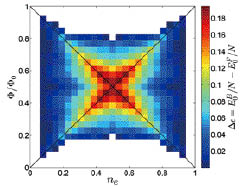Particle Statistics, Frustration, and Ground-State Energy
Oshikawa Group
Quantum statistics of identical particles is one of the most fascinating aspects of quantum mechanics. The wavefunction does not change when two identical bosons are exchanged, while it acquires a negative sign when two identical fermions are exchanged. This fundamental distinction leads to various differences in physical properties between a system of many bosons and that of many fermions. For example, fermions obey Pauli exclusion principle, which forbids more than one particles to occupy the same single-particle state. In contrast, any number of bosons can occupy the same single-particle state, concerning the quantum statistics. In fact, at sufficiently low temperatures, a macroscopic number of bosons may occupy the same single-particle state. This is the celebrated Bose-Einstein Condensation, which has been directly observed in ultracold atoms.

Fig. 1. Comparison of the ground-state energies of fermions and hard-core bosons on the square lattice of 26 sites. The horizontal axis is the number of particles ne per site, and the vertical axis is the flux per plaquette Φ in unit of the flux quantum Φ0. The ground-state energy of fermions is lower than that of bosons in the colored region, and the difference is most significant in the red-colored region, where ne = Φ/Φ0 or an equivalent relation approximately holds.
Let us consider two systems with the “identical” Hamiltonian, but the one consists of many bosons and the other consists of many fermions. By “identical” Hamiltonian we mean the single-particle eigenstates and their energy eigenvalues are identical. Our question is: which system has the lower ground-state energy, the one of bosons or that of fermions? It might appear a trivial question, since in the ground state all the bosons will occupy the lowest-energy single-particle eigenstate, while most of the fermions will occupy higher energy single-particle eigenstates because of the Pauli exclusion principle. Then the ground-state energy of fermions would be always higher than that of bosons. However, this simple argument is only valid when there is no interaction. When there is an interaction between the particles, as is the case in realistic systems, the Bose-Einstein Condensation is not perfect. Thus the comparison is a nontrivial question in the presence of interaction.
We first proved [1] a theorem which states: even in the presence of interaction, bosons have a lower ground-state energy if all the hopping amplitudes are positive. This theorem can be understood in terms of frustration among quantal phases; if all the hopping amplitudes are positive, there is no such frustration in the system of bosons while fermions are subject to frustration due to their quantum statistics. We can violate the assumption of the theorem by introducing negative and/or complex hopping amplitudes. This makes it possible that the inequality between the ground-state energies to be reversed. This again can be understood in terms of frustration introduced among hoppings. In fact, we succeeded in constructing several concrete examples, in which the ground-state energy of fermions is lower than that of corresponding bosons [1]. This includes a rigorous proof on the delta-chain case, for which the reversal was reported earlier on small clusters [2].
References
- [1] W. Nie, H. Katsura, and M. Oshikawa, Phys. Rev. Lett. 111, 100402 (2013).
- [2] S. D. Huber and E. Altman, Phys. Rev. B 82, 184502 (2010).
